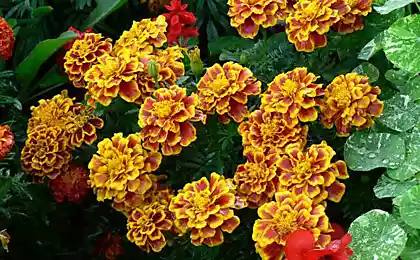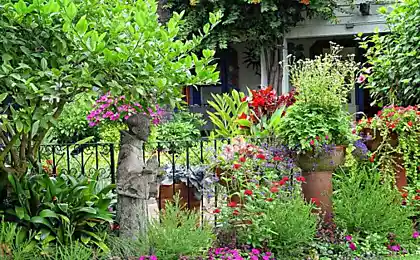484
Marigolds – velvet chic to your garden
Marigolds a fairly common plant in our gardens, such they got the name thanks to its flowers, petals that look like velvet fabric. In Ukraine they are called chernobrivtsi in Poland – aksamitka in Germany – student's flowers, and in England marigold – Mary's gold.
The genus Tagetes is the scientific name for marigold belongs to the Asteraceae family and comprises over 30 species, both annual and perennial herbaceous plants. Came to us marigolds from South America, where they still grow in large quantities in natural conditions. Representatives of this species can be found in the wild in Central America, in the West Caucasus, you can also in nature, to meet wild species of this plant. Popular marigolds around the world, especially cultivated varieties with large flowers.

Description of the plant
Marigolds have erect and branched stems, branches per plant form a compact spreading shrub with a height from 20 to 120 cm, depending on variety. Plants have a fibrous root system. Leaves pinnatisect or lobed, rarely seen varieties with solid and serrated leaves. By the color of the leaves can be from light to dark--green, they are arranged oppositely or alternately. Chernobrivtsi the flowers are quite bright, their flowers can be simple or double, are collected in inflorescence. The color of the blossoms range from yellow, orange or brown species, displayed the same plants with white and greenish flowers.
Inflorescence usually of average size, but there are large-flowered varieties. Species with small flowers are found only in the wild.
Blooming plants from June until the first frost.
Seeds collected boxes, the seed is black or black-brown strongly flattened. Achenes remain viable for 3-4 years.

Flowers during flowering, very fragrant smell, a smell similar to the smell of asters, but more severe, is perceived by all. Marigolds – the flowers are not picky about growing conditions, read more about this in the article:
Marigold pests and diseases
The most common diseases they can be called root rot and black leg.
Disease of marigold
Black leg
Black leg is found in these plants most often at a young age.
In the lower part of the stem, there are bright spots, then they start to darken and rot on stems appear banners, in result, the plants die and wither.
To prevent the occurrence of this disease is seed and soil before sowing marigolds, be sure to etch fungicides, and when watering young seedlings from time to time use a weak solution of potassium permanganate. But you shouldn't use this watering too often, the manganese if used frequently inhibits the plant.
If despite all precautions you noticed that the black leg is still there, you should immediately remove infected plants to reduce the frequency of watering, and make watering only when the top layer dries up. The ground around the unaffected plants should be sprinkled with wood ashes or perlite. If all these measures do not give special effect transplant the plants into fresh soil as soon as possible.
Root rot
The grown plants in the open ground susceptible to root rots, it is a consequence of the emergence of adverse conditions. Symptoms are stunting, yellowing of the stem and leaves. If time does not pay attention to these symptoms, the plant dies. To prevent the disease should establish the plants optimal conditions: ground when planting plants should be loose and not samokat in the process of growth of chernobrivtsev should make timely weeding and loosening soil, as well as to avoid excessive watering and standing water. To avoid diseases you should not fertilize the plants with fresh manure, and planted in places where last season was seen plants affected by this disease.
Viral diseases
In summer, large plantings of marigolds can receive the plants, which shoots turned yellow, and the leaves are deformed and mottled yellow, beige or brown. Also on these plants, you notice the underdeveloped buds and no seeds. So these plants were subjected to virus diseases, and these diseases are not treatable. Therefore, as the discovery of plants with such symptoms should be immediately removed and burned.
Pests of marigolds
Among the pests, these plants are often damaged by spider mites, whiteflies and slugs.
Spider mites
This pest often strikes young seedlings, it appears on seedlings in dry air in the room where it is grown. But there are times when it hits and older plants in a dry and hot summer.
Symptoms of mite: leaves turn a whitish shade, and then start to dry up and later the plant dies. To deal with this pest, you can use increase the humidity of the air in the room, because the mites cannot tolerate humid air and dies.
Whiteflies
As is well established, the infusion of tobacco. Prepare it as follows: 200грам of tobacco or of tobacco pour three liters of water and leave to infuse for two days. After this infusion should strain and dilute with water to volume of ten liters. Then the solution was added 50 grams of shredded soap and all is well stirred until the soap dissolved. Infusion is used immediately after preparation.
Whiteflies
When growing seedlings in greenhouses and greenhouses the marigolds threatens another pest, the whitefly. Most often this happens in the greenhouses, and in hot weather outdoors.
Slug
This little white butterfly is not enough that sucks the SAP from the leaves of plants, and secretions of the larvae of its leaves affected by fungi sooty and blackened. In severe cases it is necessary to spray the plants with special preparations, such as actar.
Slugs and snails
Slugs and snails affect these plants in wet weather, they gnaw the stems and eat the leaves of plants. To deal with these pests can gathering them from plants, sprinkling the soil around the flower ash mixed with lime.
Source: www.art-pen.ru
The genus Tagetes is the scientific name for marigold belongs to the Asteraceae family and comprises over 30 species, both annual and perennial herbaceous plants. Came to us marigolds from South America, where they still grow in large quantities in natural conditions. Representatives of this species can be found in the wild in Central America, in the West Caucasus, you can also in nature, to meet wild species of this plant. Popular marigolds around the world, especially cultivated varieties with large flowers.

Description of the plant
Marigolds have erect and branched stems, branches per plant form a compact spreading shrub with a height from 20 to 120 cm, depending on variety. Plants have a fibrous root system. Leaves pinnatisect or lobed, rarely seen varieties with solid and serrated leaves. By the color of the leaves can be from light to dark--green, they are arranged oppositely or alternately. Chernobrivtsi the flowers are quite bright, their flowers can be simple or double, are collected in inflorescence. The color of the blossoms range from yellow, orange or brown species, displayed the same plants with white and greenish flowers.
Inflorescence usually of average size, but there are large-flowered varieties. Species with small flowers are found only in the wild.
Blooming plants from June until the first frost.
Seeds collected boxes, the seed is black or black-brown strongly flattened. Achenes remain viable for 3-4 years.

Flowers during flowering, very fragrant smell, a smell similar to the smell of asters, but more severe, is perceived by all. Marigolds – the flowers are not picky about growing conditions, read more about this in the article:
Marigold pests and diseases
The most common diseases they can be called root rot and black leg.
Disease of marigold
Black leg
Black leg is found in these plants most often at a young age.
In the lower part of the stem, there are bright spots, then they start to darken and rot on stems appear banners, in result, the plants die and wither.
To prevent the occurrence of this disease is seed and soil before sowing marigolds, be sure to etch fungicides, and when watering young seedlings from time to time use a weak solution of potassium permanganate. But you shouldn't use this watering too often, the manganese if used frequently inhibits the plant.
If despite all precautions you noticed that the black leg is still there, you should immediately remove infected plants to reduce the frequency of watering, and make watering only when the top layer dries up. The ground around the unaffected plants should be sprinkled with wood ashes or perlite. If all these measures do not give special effect transplant the plants into fresh soil as soon as possible.
Root rot
The grown plants in the open ground susceptible to root rots, it is a consequence of the emergence of adverse conditions. Symptoms are stunting, yellowing of the stem and leaves. If time does not pay attention to these symptoms, the plant dies. To prevent the disease should establish the plants optimal conditions: ground when planting plants should be loose and not samokat in the process of growth of chernobrivtsev should make timely weeding and loosening soil, as well as to avoid excessive watering and standing water. To avoid diseases you should not fertilize the plants with fresh manure, and planted in places where last season was seen plants affected by this disease.
Viral diseases
In summer, large plantings of marigolds can receive the plants, which shoots turned yellow, and the leaves are deformed and mottled yellow, beige or brown. Also on these plants, you notice the underdeveloped buds and no seeds. So these plants were subjected to virus diseases, and these diseases are not treatable. Therefore, as the discovery of plants with such symptoms should be immediately removed and burned.
Pests of marigolds
Among the pests, these plants are often damaged by spider mites, whiteflies and slugs.
Spider mites
This pest often strikes young seedlings, it appears on seedlings in dry air in the room where it is grown. But there are times when it hits and older plants in a dry and hot summer.
Symptoms of mite: leaves turn a whitish shade, and then start to dry up and later the plant dies. To deal with this pest, you can use increase the humidity of the air in the room, because the mites cannot tolerate humid air and dies.
Whiteflies
As is well established, the infusion of tobacco. Prepare it as follows: 200грам of tobacco or of tobacco pour three liters of water and leave to infuse for two days. After this infusion should strain and dilute with water to volume of ten liters. Then the solution was added 50 grams of shredded soap and all is well stirred until the soap dissolved. Infusion is used immediately after preparation.
Whiteflies
When growing seedlings in greenhouses and greenhouses the marigolds threatens another pest, the whitefly. Most often this happens in the greenhouses, and in hot weather outdoors.
Slug
This little white butterfly is not enough that sucks the SAP from the leaves of plants, and secretions of the larvae of its leaves affected by fungi sooty and blackened. In severe cases it is necessary to spray the plants with special preparations, such as actar.
Slugs and snails
Slugs and snails affect these plants in wet weather, they gnaw the stems and eat the leaves of plants. To deal with these pests can gathering them from plants, sprinkling the soil around the flower ash mixed with lime.
Source: www.art-pen.ru























